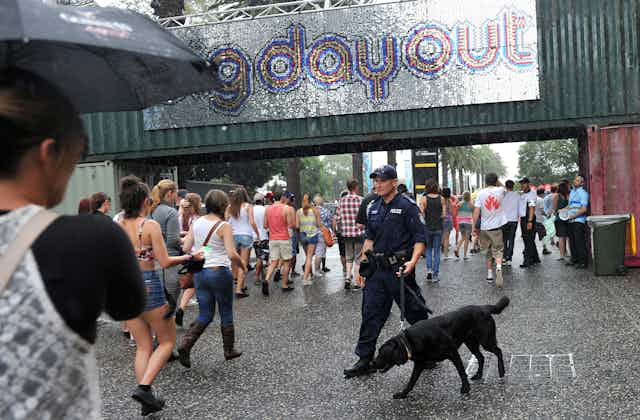For young people who attend music festivals, the sight of drug-detection dogs patrolling entrances is a familiar one. But how effective are they in minimising harm, given music festivals in Australia were recently marred by two more deaths by overdose and multiple hospitalisations?
These dogs don’t stop most drug use. And they have been shown to encourage more dangerous practices, criminalise and traumatise marginalised groups, and render all as potential suspects.
In New South Wales, where police also deploy the dogs in bars and clubs, at train stations and on the streets, Labor and Greens MPs have called for the dogs to be banned. A bill to repeal their use is currently before parliament. In Victoria, a parliamentary inquiry is underway to determine whether the dog operations should continue.
Police agencies, however, have defended the dogs, claiming they send an important message to the community that drugs are dangerous and won’t be tolerated.
Consider the negatives
Such claims overplay the deterrent capacity of the dog programs. They also ignore the negative impacts the dogs have on drug users, marginalised groups and society more broadly.
Unlike “specific” drug-detection work, where dogs assist police to locate drugs on a property following a court-issued search warrant, “general” detection work is where dogs are used in public or institutional settings to home in on people who might be carrying drugs.
In the latter circumstances, a positive dog “alert” is used to constitute, or supplement, the reasonable suspicion necessary to conduct a search.
The use of a dog in these contexts no doubt helps police to increase the odds, compared to a random stop, that someone they search will be carrying drugs. However, these benefits are substantially offset by:
most people found with drugs carrying only small quantities for personal use, rather than traffickable amounts;
most who are carrying drugs not being identified by the dogs; and
the vast majority of those who are identified by the dogs (60-80%) not being found to be carrying any drugs.
Why do false-positive readings happen?
False positives may – as police claim – be caused by odour from previous contact with drugs, or drugs that have been stashed in an unsearched internal cavity.
But the dogs can also be affected by the context; they can become tired, hungry, or confused by multiple odours, noises and distractions.
And it is very likely that intentional and unintentional cues by dog handlers, who are trained to profile people based on behaviour, appearance and comportment, are to some degree interfering with the dogs’ identifications.
Dogs are naturally responsive to even the subtlest of human cues. Scent-detection dogs were found to be more likely to falsely alert to locations when their handler believed drugs to be present, with handler beliefs influencing dog alerts even more than food decoys.
In my own observational research, I have documented plain-clothed police at two different festival entrances directing dog handlers to specific persons of interest. Such practices, along with other less explicit biases and cues, may have impacts on alert accuracy.
Such cues may also be exacerbating the discriminatory impacts of general drug-detection dogs. The locations chosen for deployment are having disproportionate effects on certain marginalised groups, such as LGBTI+ people, Aboriginal communities, poorer populations and young people. And potential biases in the cues being given might be compounding these effects.
The dogs’ high false-positive rate in public contexts also has implications for their legality. Australian courts are yet to test whether a 20-40% accuracy is enough to constitute the reasonable suspicion necessary for a search.
In the meantime, police agencies tend to cautiously advise their personnel that a positive dog alert can only be used to form part of that suspicion, without specifying what other grounds can be used to make up the rest.
Civil liberties are being affected
With more than 15,000 people searched based on drug-dog alerts each year since 2009 in NSW alone, it is not surprising that serious concerns about civil liberties and police-community relations are being raised.
The experience of being searched by police with detection dogs can perhaps be likened to being scanned at an airport, or having your bag searched in a store. Even in the absence of wrongdoing, searches produce a sense of oneself as suspect. It is a feeling no doubt compounded for those whose marginalised identities render them already unduly suspect.
Almost all of those I have interviewed who have been searched, whether carrying drugs or not, experienced some form of embodied emotional trauma, such as anxiety, humiliation, anger, frustration and shame. Others have reported similar experiences of violation and trauma.
Proponents of the drug-dog operations might assume that exposing people to this kind of fear and shame is a good way to deter them from using drugs. Yet fear and shame tend to be very poor motivators of positive behaviour change. Instead, they can have worrying side effects such as increased anxiety, reduced health-seeking behaviours, and impacts on broader social relations.
More harm than good?
Even highly publicised drug-dog operations tend to be ineffective as a deterrent. Rather than reducing or stopping their drug use in response to drug-dog operations, people have reported taking actions such as:
consuming drugs quickly if dogs are present;
using their drugs in advance;
stashing drugs in internal cavities;
using drugs thought to be less detectable; or
buying drugs inside a venue.
Visible, zero-tolerance-style drug policing has a negative impact on drug-user health outcomes. Drug-detection-dog operations are no different.
When drug users are shaping their drug-use behaviours in order to best avoid police dogs problems inevitably arise, including heightened risk of overdose death. At least two deaths have been directly associated with panicked ingestion after seeing drug dogs.
The negative impacts of drug detection dog use far outweigh any benefits associated with the confiscation of generally small amounts of drugs from a small proportion of drug users. Police services should look at ending these operations now.
This article has been amended since publication.

